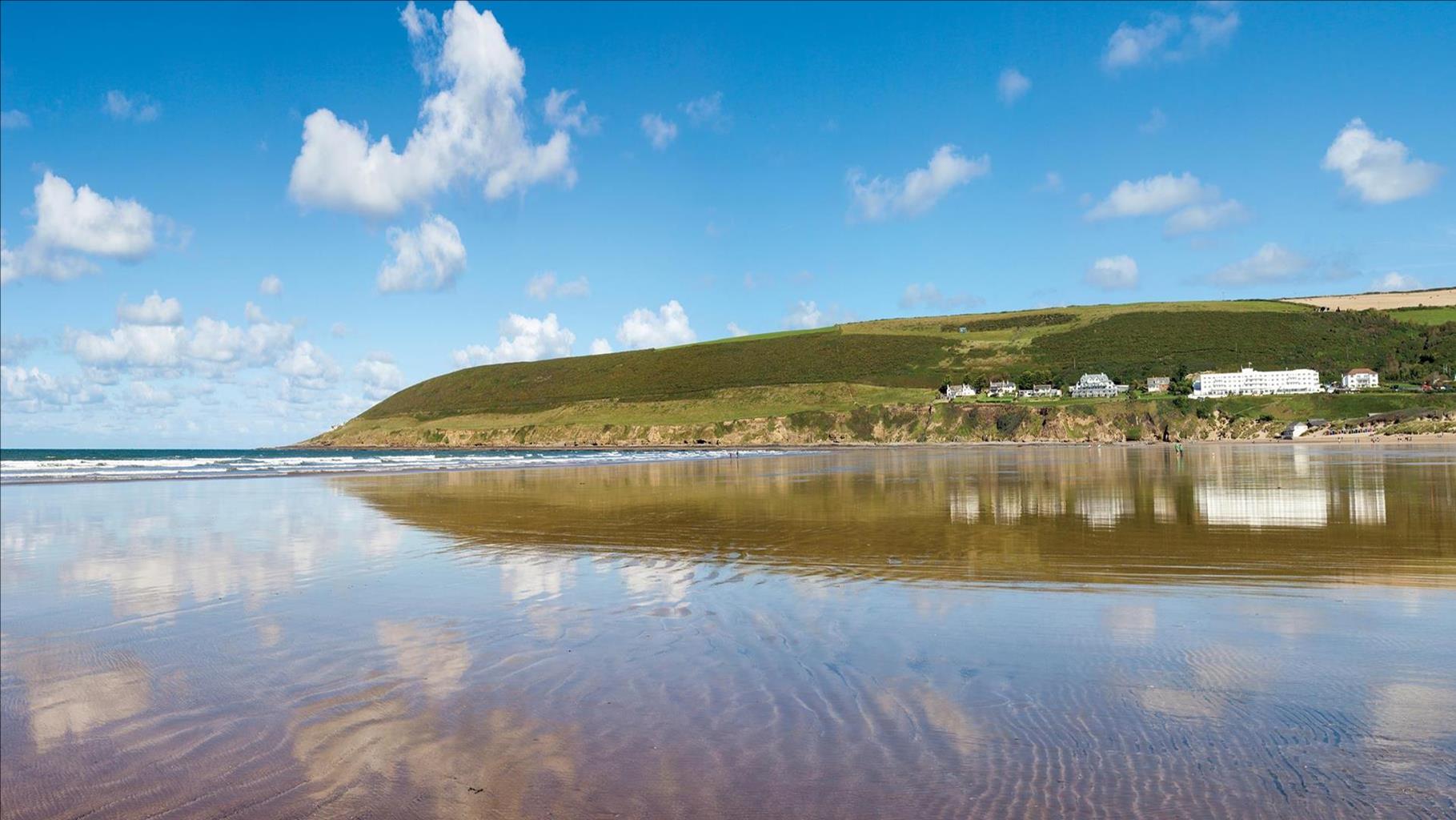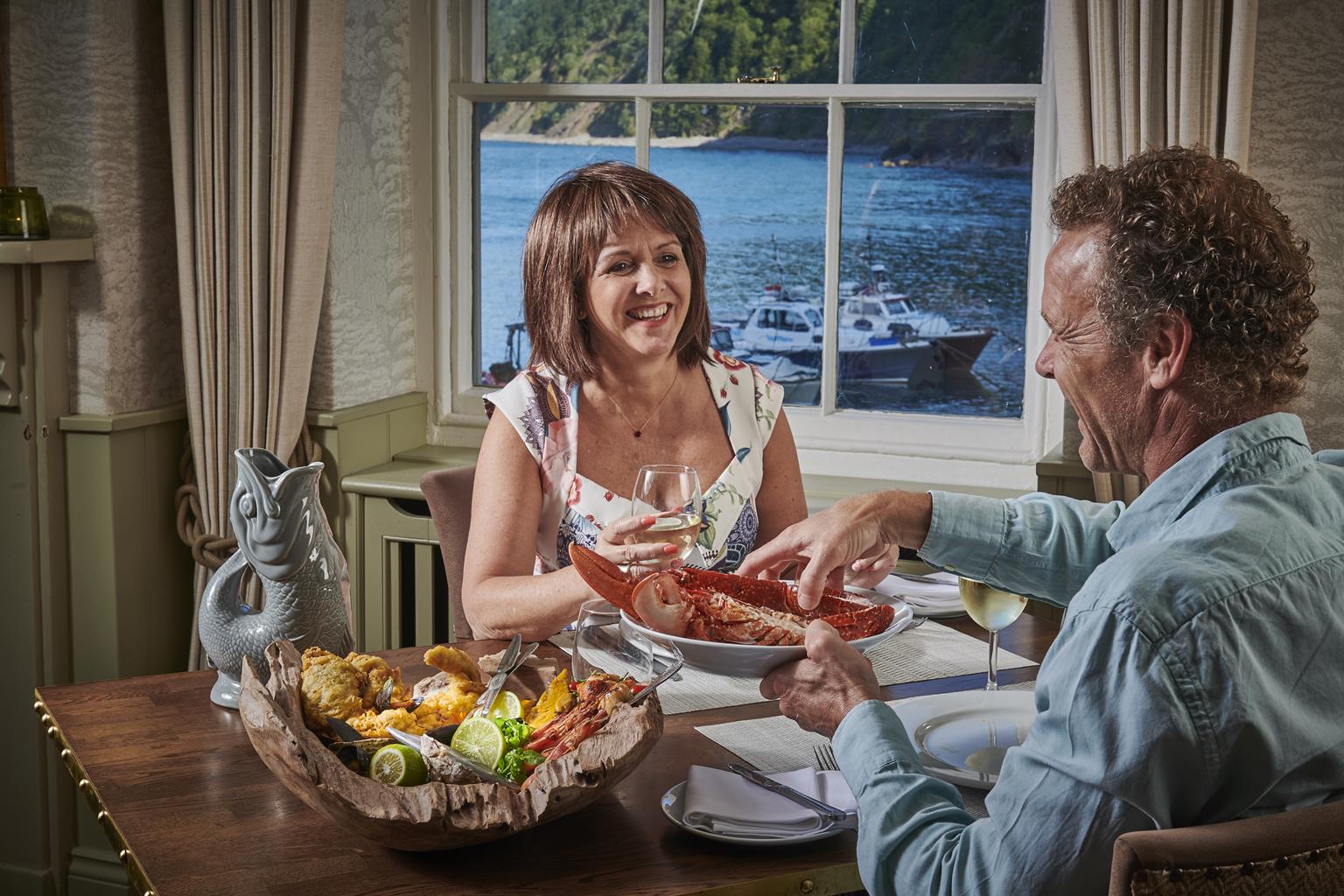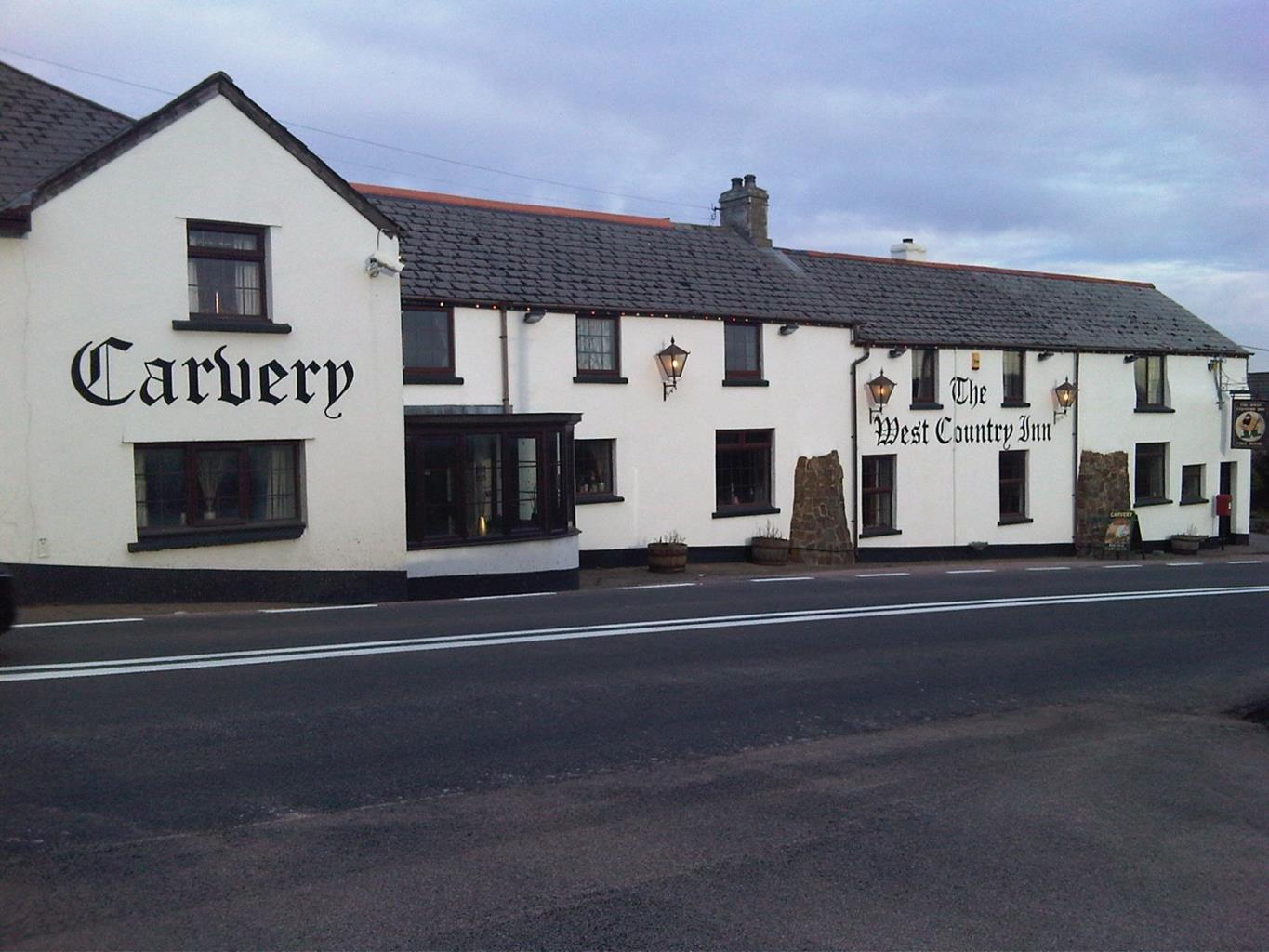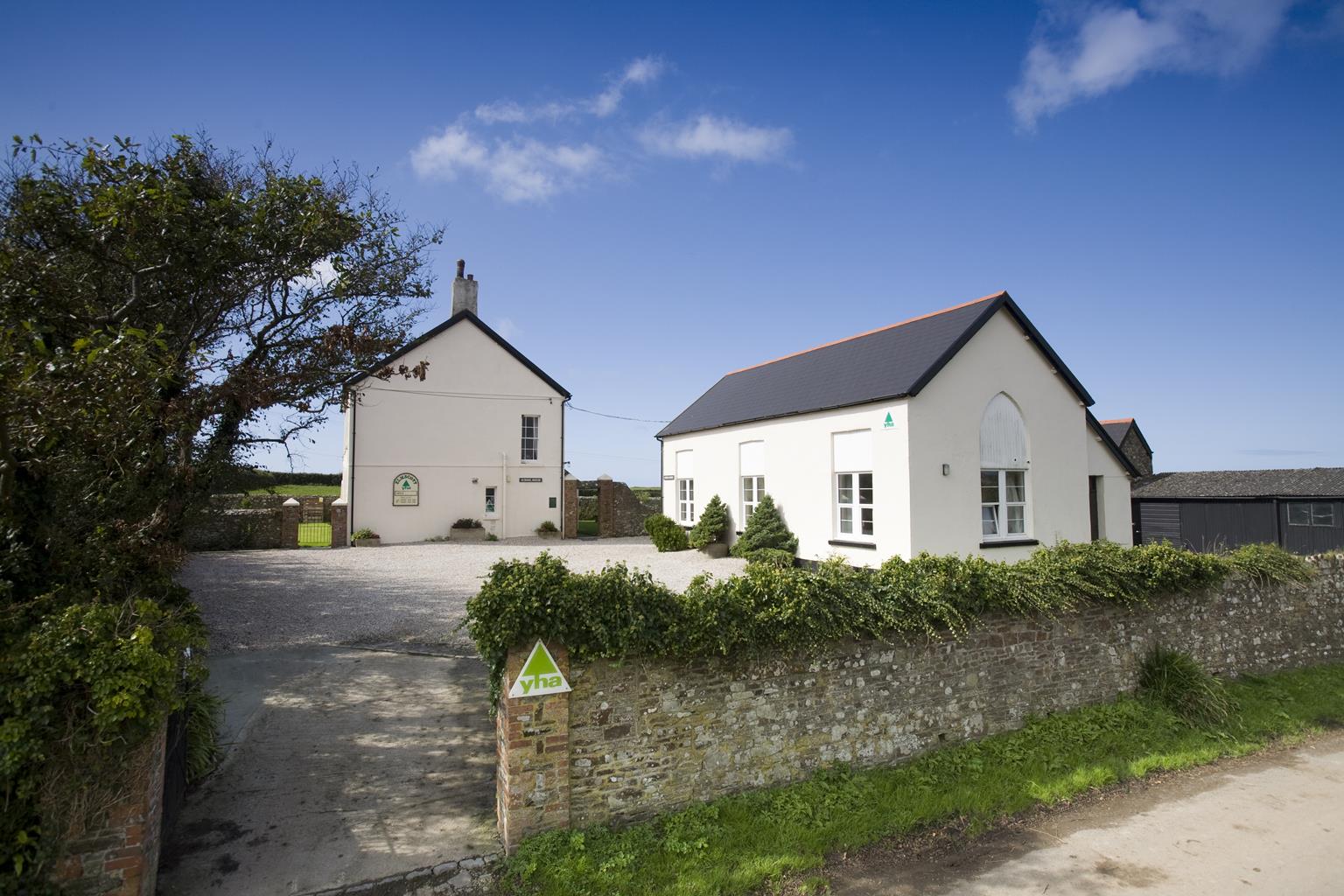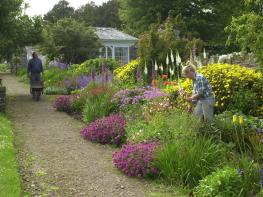The Red Lion Hotel is an 18th century 4-star inn that stands on the quay alongside Clovelly’s…
Clovelly and the coast

6 miles (9.7kms)
About the walk
Everyone’s heard about Clovelly. It’s an extraordinary place – almost a folly itself – best seen very early in the morning, or at the end of the day when most visitors have gone home. Clinging precariously to the wooded cliffs on the long, virtually uninhabited stretch of inhospitable coastline between Bideford and Hartland Point, it has a timeless feel if you see it ‘out of office hours’, or in midwinter. Once famous as the village where donkeys were used to carry goods – and people – from the quay up the perilously steep cobbled village street (the bed of an old watercourse), today it is best known as a tourist trap. Most people drive to the village and are drawn into the Visitor Centre car park at the top – but it’s much more satisfying, and more fitting to Clovelly’s situation, to walk in along the coast path from the National Trust lands at Brownsham to the west. The two 17th-century farmhouses of Lower and Higher Brownsham (now holiday accommodation) lie just inland from one of the most unspoiled sections of the coastline. Although the walk is often under trees, you can still hear the pull and drag of the waves on the shingly beach far below.
Charles Kingsley, social reformer and author of Westward Ho! and The Water Babies, lived in Clovelly as a child when his father was rector of All Saints Church. Clovelly featured heavily in Westward Ho!, published in 1855, and the world suddenly became aware of this remote village's existence. Up until then it had been reliant on herring fishing for its main source of income. Charles Dickens also mentioned Clovelly in A Message from the Sea (1860).
Clovelly Court dates from around 1740, when the Hamlyns bought the manor from the Carys, but was remodelled in Gothic style in 1790–95. The gardens open daily from 10am to 4pm, and there is a small admission fee. The restored 15th-century All Saints Church has a Norman porch, dating from around 1300, and many monuments to the Cary and Hamlyn families. Sir James Hamlyn, who died in 1829, was responsible for the Hobby Drive, which runs for 3 miles (4.8km) along the cliffs east of Clovelly, and from which you get fantastic views of the harbour below.
Walk directions
Follow the footpath from the back of the car park, signed ‘Breckland Woods’. Pass through a gate and turn right as signed towards the coast path; soon pass a bench at a path junction. Keep ahead over a stile; walk on to cross another onto the coast path.
Go right through a gate (signed ‘Mouthmill’) into a field on Brownsham Cliff, with good views ahead to Morte Point. Keep along the left edge, through a gate, down steps and along the left edge of the next field. Cross a stile and zigzag downhill through woodland. At the bottom turn left towards the beach, passing a lime kiln.
Follow the coast path across the rocky beach. Clamber up a gully to meet a track on a bend; walk uphill (left fork).
Eventually follow coast path signs left, then immediately right. Go left up wooden steps to follow a narrow, wooded path steeply uphill towards the open cliff at Gallantry Bower, with a 400ft (122m) drop into the sea. Re-enter woodland and follow the coast path to pass the ‘Angel’s Wings’ folly. Where a path leads straight on to the church, keep left following signs and later via a gate through the edge of Clovelly Court estate. Enter laurel woods via a kissing gate. The path winds down and up past a stone shelter, then through a kissing gate into a field. Keep along the left edge to meet the road at a big gate. Follow coast path signs on to the road ahead that leads to the path to Clovelly village, below the Visitor Centre.
Leave the coast path and walk up deep, steep, ancient Wrinkleberry Lane (right of Hobby Drive ahead) to a lane, past the former school building and on to meet the road. Turn right, downhill.
Where the road bends right keep ahead on a path parallel to the drive to Clovelly Court. At the church turn left; keep ahead on the lane towards Court Farm, soon passing through the farm. Once past the buildings keep ahead on a track between fields. Pass through a plantation, then bear diagonally right downhill across a field.
Go through a gate to the left of the far corner bridlepath. At the end of the next field go through a gate into a plantation, downhill.
Turn left on the forest track, following bridleway signs. Turn right as signed to cross the stream and up the long, gradually ascending track to Lower Brownsham Farm. Turn left for the car park.
Additional information
Grassy coast path, woodland and farm tracks, several stiles
Farmland, wooded coast path and deep combes
Keep on lead near livestock and unfenced cliffs
OS Explorer 126 Clovelly & Hartland
National Trust car park at Brownsham
In the visitor centre at the car park in Clovelly
WALKING IN SAFETY
Read our tips to look after yourself and the environment when following this walk.
Find out more
Also in the area
About the area
Discover Devon
With magnificent coastlines, two historic cities and the world-famous Dartmoor National Park, Devon sums up all that is best about the British landscape. For centuries it has been a fashionable and much loved holiday destination – especially south Devon’s glorious English Riviera.
Close to the English Riviera lies Dartmoor, one of the south-west’s most spectacular landscapes. The National Park, which contains Dartmoor, covers 365 square miles and includes many fascinating geological features – isolated granite tors and two summits exceeding 2,000 feet among them.
Not surprisingly, in Dartmoor the walking opportunities are enormous. Cycling in the two National Parks is also extremely popular and there is a good choice of off-road routes taking you to the heart of Dartmoor and Exmoor. Devon’s towns and cities offer stimulating alternatives to the rigours of the countryside.
Nearby stays
Restaurants and Pubs
Nearby experiences
Recommended things to do
Why choose Rated Trips?
Your trusted guide to rated places across the UK
The best coverage
Discover more than 15,000 professionally rated places to stay, eat and visit from across the UK and Ireland.
Quality assured
Choose a place to stay safe in the knowledge that it has been expertly assessed by trained assessors.
Plan your next trip
Search by location or the type of place you're visiting to find your next ideal holiday experience.
Travel inspiration
Read our articles, city guides and recommended things to do for inspiration. We're here to help you explore the UK.







